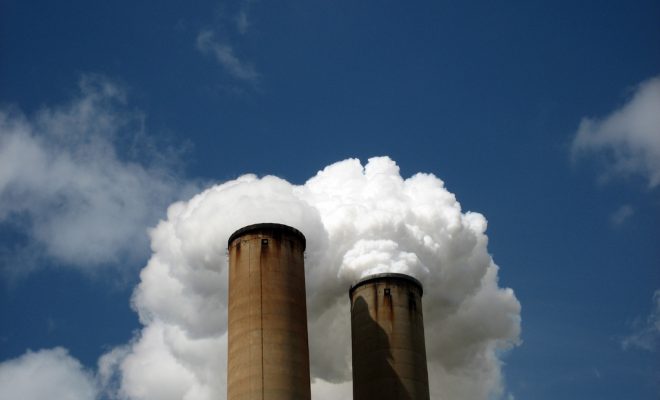 "Big Bend Power Station" courtesy of Mrs. Gemstone; License: (CC BY-SA 2.0)
"Big Bend Power Station" courtesy of Mrs. Gemstone; License: (CC BY-SA 2.0)
Energy & Environment
The Impact of Environmental Regulations on Business
President Donald Trump has long promised to remove as many environmental regulations as possible in order to allow American businesses room to grow and prosper and now seems ready to follow through on his pledge. Conservatives and libertarians have spoken out in widespread support of reducing regulations and its ability to stimulate growth. However, many of the regulations that Republicans believe hamper business productivity are in fact key provisions in the Clean Air and Clean Water Acts that form the legal cornerstone for American public health.
More broadly, this narrative that environmental regulations (or really any sort of environmental policy) are damaging to business in American is a timeless conservative stance. But is it really true? Have environmental regulations really dampened the ability of business to succeed in America? Can regulations really be blamed for more and more industries outsourcing to countries that have less stringent rules? Could Trump’s infrastructure plan fix our water contamination in areas like Flint? What is the real, quantified benefit of regulations on American public health and why is it never discussed in these conversations? This is one of the oldest arguments against environmental policy measures and it deserves to be analyzed in depth. Read on to learn about the history and impact of environmental regulations on business, public health, and America as a whole.
The Birth of the EPA and the Clean Air and Clean Water Acts
The advent of environmental regulations in America really begins with the creation of the Environmental Protection Agency in 1970. Prior to the 70s, environmental rules were up to each state to determine independently; regulations were generally loose and chemical dumping was a common, widespread industrial practice. It should come as no surprise that America also had significantly worse water and air quality than it does currently. Only about a third of U.S. fresh water was safe to drink from and watersheds across the nation contained dangerous quantities of unsafe pathogens and hazardous chemicals. With the creation of the EPA came the passage of two critical laws, the Clean Water Act of 1972 and the Clean Air Act of 1972.
Using the Clean Water Act, the EPA permanently barred individuals from dumping their waste in navigable waterways and established a dumping permit system for industrial and municipal facilities. These permits could be revoked if any company exceeded the wastewater standards set by the agency, and the removal of a permit resulted in an operational shutdown. The Clean Air Act of 1972 gave the EPA the power to set National Ambient Air Quality Standards for six major pollutants: nitrogen dioxide, particulate matter, ozone, sulfur dioxide, lead, and carbon monoxide. The impact of these acts has been huge. Beyond their immediate environmental benefits, these laws set a legacy of top-down, federal environmental regulation ensuring that America has some of the cleanest water and safest air in the world.

“Smog” courtesy of Isengardt; License: (CC BY 2.0)
Costs and Benefits on the National Scale
The technological changes required by these laws have been significant. Power plants throughout the nation were required to update their systems and install filters on their smokestacks. The transportation sector has perhaps experienced the greatest changes out of all the affected industries as the EPA’s National Ambient Air Quality Standards (NAAQS) required massive modifications to engine efficiency and emission filtration systems. Congress created the Corporate Average Fuel Economy (CAFE) standards in 1975, which required certain fuel efficiency rates for different fleets of vehicles. The combined effects of the NAAQS and CAFE standards have dramatically increased the fuel efficiency of our transportation sector and subsequently reduced petroleum use and its pollutant emissions.
And did we gain anything? Actually, yes. Thanks to the Clean Water Act and its subsequent amendments, the percentage of drinkable fresh water in the United States rose from about 30 percent to well over 60 percent. The six major air pollutants in our atmosphere dropped by over 69 percent between 1972 and 2014. One of the reasons analyzing regulatory costs and benefits is complicated is because the losses are felt by private businesses, but the gains are felt in a completely different area: public health. In 2010 alone, Clean Air Act regulations led to the avoidance of an estimated 160,000 premature deaths from respiratory-related illnesses, 130,000 heart attacks, and millions of cases of acute bronchitis, emphysema, and asthma. By 2020 the effects of the act are projected to prevent over 230,000 premature adult deaths annually.
These benefits don’t just lengthen lives, they also increase productivity throughout a lifetime. In 2010, over 13 million lost workdays and 3.2 million lost school days were avoided. All this has a direct benefit to the productivity of our workforce and the academic success of our students, which eventually aids American businesses by creating educated workers. Furthermore, employers provide health insurance for 59 percent of U.S. citizens, meaning that businesses will often end up directly shouldering the burden of increased health care costs when their workers get sick. In 1990, the Clean Air Act was amended to create a regular review of its costs and savings, the conclusion of which was that the benefits of these programs exceeded their compliance costs by a factor of over 43 to 1, based on the average of the estimated range of savings. In the 20 years since the annual review was first conducted, estimates suggest that the Clean Air Act has generated a staggering $22.2 trillion in savings for the United States compared to only $0.5 trillion in compliance costs for the businesses forced to adapt to new regulations.
But did it stifle the overall growth of American business? No, not really. Between 1970 and 2011, U.S. GDP increased by 212 percent and private sector jobs increased by 88 percent. Even the fossil fuel sector, the industry that stood to lose the most from new regulations, grew dramatically. Oil refineries experienced a sharp uptake in refinery productivity and coal production has increased by 70 percent since 1970.
What About Outsourcing?
It is sometimes incorrectly claimed that environmental regulations are one of the central causes for the significant trend in outsourcing that has swept through American businesses. President Trump certainly seems confident that removing regulations will help to bring back manufacturing to the U.S. But pollution abatement spending by American manufacturing is under 1 percent of the value of their total shipped goods. The primary driver in outsourcing is and has always been a desire to reduce labor costs. It would require much more than just dropping environmental regulations to actually induce companies to return to America (it would also most likely require slashing the minimum wage and dropping most workers’ rights) and the impacts of allowing large industries to pollute freely in this country would be significant.
One only needs to look at the difference in a citizen’s life expectancy and the staggering public health costs in industrialized nations without regulations compared to countries like our own. The World Bank has an exhaustive report on the available data. To do away with regulations will cause a dramatic drop in human health in the United States and would lead to an explosion in public health costs.
It is also overlooked that environmental regulations do encourage growth, as new regulatory mechanisms have consistently led to an increased demand for private tech providers, which are needed to create newly required technology. The American environmental technology sector is actually huge, generating around $300 billion in annual revenues, consisting of 119,000 companies, and providing more than 2.6 million jobs to American citizens. Air pollution control equipment alone generated $18 billion in revenue in 2008. Currently, the United States has the largest Environmental Technology industry in the world, making up about a third of the global market.
Pollution control industries create jobs for engineers, scientists, project managers, construction workers, etc., meaning there are employment opportunities for people of all educational levels. The growth of the pollution control sector also benefits some of the industries it was ironically, and incorrectly, predicted to disrupt–such as steel and plastics manufacturing–which are required to provide the materials for newly developed technology.

- “Polluted Malad Creek at Lokhandwala,Mumbai” courtesy of Ravi Khemka; License: (CC BY 2.0)
Business v. Environmentalism: Flint, Michigan
Much of Trump’s campaign was focused on revitalizing the rust belt through manufacturing and Flint can act as a viable case study for how Trump will impact public health and manufacturing. Flint, Michigan attracted national attention when elevated lead levels were found in many citizens’ blood from drinking contaminated water. Governor Rick Snyder appointed an Emergency Manager to Flint, Darnell Earley, who took control of the city’s budget and switched water sources from the drinkable Lake Huron to the toxic Flint River. The citizens took their complaints to the state Health Department and the Michigan Department of Environmental Quality but both agencies largely ignored their concerns. It took nearly a year before the EPA heard about the problems with Flint’s water and the agency has been strongly criticized for not mobilizing rapidly and effectively enough to address the situation after it knew about it. Flint is a very serious story of how poor communication and utilization of federal resources failed a community in a serious way. What it is not is a story that indicates the EPA should be defunded and environmental regulations should be pulled.
The willful flouting of environmental regulations and requirements was what created the crisis in Flint to begin with. While untreated lead pipes used to be the norm in the United States, numerous laws have been passed over the years to protect American communities from lead poisoning. The Safe Drinking Water Act, amended in 1986, prohibited new pipe installations from using lead and the 1991 Lead and Copper Rule (originally devised under Ronald Raegan and put into action by George H.W. Bush) required all lead pipes in America to either be replaced or be used in tandem with additional water treatment. While replacing existing pipes by using less dangerous alternatives, such as PVC, was heavily encouraged, many municipalities, especially in poorer areas, chose to go the cheaper route and use corrosion inhibitors. The Flint City Water Treatment Plant ignored these federal regulations and made the decision not to use anti-corrosion chemicals for their water system during a time when chemical costs were spiking. Skipping corrosion control saved Flint $140 a day, which pales in comparison to the costs of addressing the damage. Automotive factories witnessing their approaching collapse due to foreign competition chose to ignore federal water protection rules. Years and years of dumping toxic waste made the water in the Flint River particularly corrosive. These sorts of things are exactly what the preventative measures the EPA has set in place are there to prevent, and generally, those measures have been successful. Only one-third of American water was safe to drink before the Clean Water Act whereas that number has doubled because industrial dumping has been cracked down upon.
Addressing Environmental Problems
The most important service the EPA provides is preventative, in the form of regulations protecting people and the environment from pollution. However, a major part of the agency is also focused on pollution restoration through the superfund program. Defunding the EPA will both remove these preventative measures and take away the safety net in place to fix things when pollution does happen. The EPA superfund program was created in 1980 by President Jimmy Carter in order to restore polluted areas, although it has faced legitimate criticism for not accomplishing enough and not addressing many of the sites that have applied for superfund assistance. The superfund program works on a “polluter pays” principle that requires the industry responsible for the contamination to fund a large part of the project. In areas like the Rust Belt, where many of the industries responsible for pollution went bankrupt, there is often no one to hold accountable and restoration projects are severely underfunded. However, this is not to say that the program is worthless; since its conception, the EPA has restored over 1,100 sites from severe pollution to healthy and livable communities and created circumstances for businesses to grow and thrive within those areas. Superfund is one of Americans most critical programs for protecting marginalized and endangered American communities and it needs not to be abandoned but to have improved efficiency, administration, and a more reliable funding system for when industries can’t be held accountable for pollution.
President Trump’s proposed solution would be to allocate $1 trillion toward American infrastructure at what he claims would be no cost to taxpayers–by giving $160 billion in tax credits to companies that get involved with new projects. However, Wilbur Ross and Peter Navarro, the advisers behind his plan, admit that the plan can’t actually be self-financing. The private sector will require tens of millions of collective tolls and fees for the infrastructure projects taken from the communities in which the work is done. This means that while wealthy investors stand to make a profit through the infrastructure credits, the poorest and most in-need communities like Flint likely won’t benefit because such projects would not yield the profits necessary for private investors. Infrastructure improvements also won’t replace the direct medical benefits that the EPA has been supplying to the community in the form of lead absorption food packages and chemical treatments to restore the waterways. Now that they have a majority in Congress, Republicans have already started to chip away at environmental regulations, blocking the stream protection rule that controlled coal mining and dumping near waterways. The party’s deregulatory efforts will likely continue over the coming years.
Conclusion
Trump and his team of fossil fuel friendly advisers can do plenty to change the balance of environmental regulation and public health over the next several years. Opening up protected land to drilling, mining, and fracking while also removing environmental regulations places our water and air in harm’s way. Undoing regulations will not, in any sense, be the deciding factor that brings back outsourced manufacturing jobs to the United States, not as long as we have basic labor rights and mandated benefits that prevent companies from putting their staff in sweatshops and paying them a dollar a day.
Undoing regulations will, however, damage the growth of the pollution control industry. Extensive deregulation could even cause a notable increase in health care costs and result in a dramatic increase in cases of respiratory illnesses and eventually increased rates of premature deaths. Allowing manufacturers to dump freely poses a huge danger to American citizens’ drinking water and replacing the superfund program with incentive based infrastructure programs will do little to address environmental concerns in poor areas.
Safe water and air are privileges unique to the developed world and benefits that we’ve had for so long that they may be easy to overlook. However, they are critical to the health of our population and undoing the regulations that enable us to drink clean water and breathe clean air would be a disaster for our nation’s public health.








Comments